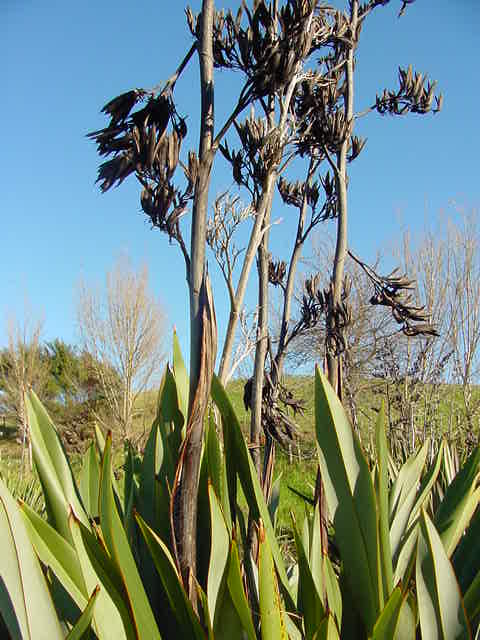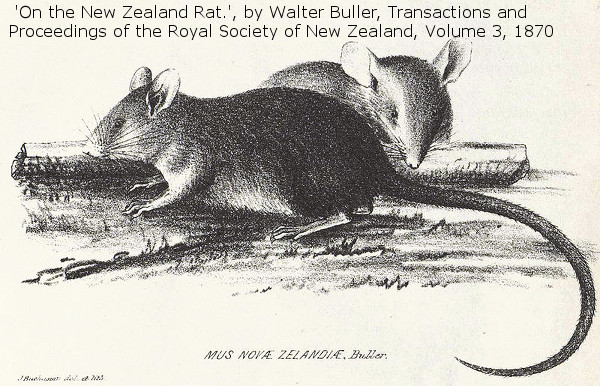Indigenous harvesting
 The relationships that many Indigenous Peoples have with nature is founded in understandings of nature as kin. Practices such as harvesting are critical components of these relationships, as are the knowledge systems that inform these practices. Harvesting is a practice that strongly connects people and the plants and animals that surround and live with us. Traditional harvest protocols have developed over many years, from decades to millenia, by Indigenous peoples. Culturally valued plants are closely managed by communities (Wehi 2006, Wehi 2009). However, harvested species are increasingly under pressure as habitat loss and environmental modification alter their population viability (Wehi and Wehi 2010, Bond et al. 2019).
The relationships that many Indigenous Peoples have with nature is founded in understandings of nature as kin. Practices such as harvesting are critical components of these relationships, as are the knowledge systems that inform these practices. Harvesting is a practice that strongly connects people and the plants and animals that surround and live with us. Traditional harvest protocols have developed over many years, from decades to millenia, by Indigenous peoples. Culturally valued plants are closely managed by communities (Wehi 2006, Wehi 2009). However, harvested species are increasingly under pressure as habitat loss and environmental modification alter their population viability (Wehi and Wehi 2010, Bond et al. 2019).  Access to traditional foods, and the plants and animals that are harvested to create these delicacies, has emerged as a critical issue for many communities. Our group is currently working with marae communities in Tainui to collect data on traditional food gathering, and its importance at major tribal gatherings such as poukai (Wehi and Roa 2020). We aim to help build cultural and biological sustainability, to support the maintenance of these meetings for many years to come.
Access to traditional foods, and the plants and animals that are harvested to create these delicacies, has emerged as a critical issue for many communities. Our group is currently working with marae communities in Tainui to collect data on traditional food gathering, and its importance at major tribal gatherings such as poukai (Wehi and Roa 2020). We aim to help build cultural and biological sustainability, to support the maintenance of these meetings for many years to come.
 Currently, habitat fragmentation and destruction are major drivers of biodiversity loss, but climate change will create further massive changes. Our group has partnered with some of Aotearoa’s most knowledgeable weavers to explore how harvesting of a culturally valued weaving plant and a key medicinal plant, in the north of New Zealand might be affected by climate change, using projected climate scenarios to estimate likely plant distribution changes and what this could mean for the communities that cherish them (Bond et al. 2019). We are now attempting to predict the environmental conditions required to maintain key phenotypic traits for kuta (Bond et al. in prep). A great joy in this collaboration has been working with Northland marae, communities, and Te Rōpū Raranga Whatu o Aotearoa.
Currently, habitat fragmentation and destruction are major drivers of biodiversity loss, but climate change will create further massive changes. Our group has partnered with some of Aotearoa’s most knowledgeable weavers to explore how harvesting of a culturally valued weaving plant and a key medicinal plant, in the north of New Zealand might be affected by climate change, using projected climate scenarios to estimate likely plant distribution changes and what this could mean for the communities that cherish them (Bond et al. 2019). We are now attempting to predict the environmental conditions required to maintain key phenotypic traits for kuta (Bond et al. in prep). A great joy in this collaboration has been working with Northland marae, communities, and Te Rōpū Raranga Whatu o Aotearoa.
 Introduced species may be valued highly by people, despite negative impacts on native ecosystems. They might, for example, provide essential food supplies for migrating peoples, either en route or in a new environment. Human-ecological values in relation to introduced species are drawn from our cultural perceptions and experiences (Wehi and Roa 2020). Our team is currently exploring representations of introduced species, and especially plants, in oral Māori tradition.
Introduced species may be valued highly by people, despite negative impacts on native ecosystems. They might, for example, provide essential food supplies for migrating peoples, either en route or in a new environment. Human-ecological values in relation to introduced species are drawn from our cultural perceptions and experiences (Wehi and Roa 2020). Our team is currently exploring representations of introduced species, and especially plants, in oral Māori tradition.  In other work, we are also considering how social justice interacts with environmental action to get rid of introduced species. One of these species is the Pacific rat or kiore (Rattus exulans). In this research, I and my collaborators tease apart some of these issues, particularly where there are strong cultural histories. I and other scientists partnered with Ngāti Wai to examine issues in kiore management in the north of Aotearoa New Zealand (Wehi et al. 2021). In New Zealand, kiore are now largely restricted to offshore islands, and although it can survive in a range of habitats, it also enjoys commensal habitat (Ricardo et al. 2020).
In other work, we are also considering how social justice interacts with environmental action to get rid of introduced species. One of these species is the Pacific rat or kiore (Rattus exulans). In this research, I and my collaborators tease apart some of these issues, particularly where there are strong cultural histories. I and other scientists partnered with Ngāti Wai to examine issues in kiore management in the north of Aotearoa New Zealand (Wehi et al. 2021). In New Zealand, kiore are now largely restricted to offshore islands, and although it can survive in a range of habitats, it also enjoys commensal habitat (Ricardo et al. 2020).
Researchers from our group are collaborating with Ngāti Wai to assess how traditional indicators of harvesting can combine with modern stock assessment methods to guide sustainable harvest yields of kiore. Kiore are traditionally harvested for food and fur in New Zealand, but are now restricted in distribution. By combining traditional indicators with modern population simulation tools incorporating the current ecological context, we aim to support harvest regimes that both increase mean annual offtake and population security over the longer term to best meet the management goals and responsibilities of the Indigenous guardians (Monks et al. submitted).
References
- Wehi PM, Watene K, Kamelamela K, Reo N (in prep). Strong with the wind: introduced species, social justice and Indigenous flourishing.
- Wehi PM, Wilson DB, Stone C, Ricardo H, Jakob-Hoff R, Jones C, Lyver PO’B. (in prep.). Managing for cultural harvest of a valued introduced species, the kiore (Rattus exulans)
- Monks A, Stone C, Wehi PM. (submitted). Benefits of traditional knowledge in a contemporary sustainable harvest assessment.
- Ricardo H, Wilson DB, Wehi PM 2020. Kiore distribution and abundance on a small highly modified island. New Zealand Journal of Zoology doi: 10.1080/03014223.2020.1785515
- Wehi PM & Roa T 2020. Reciprocal relationships: identity, tradition and food in the Kīngitanga poukai. Invited book chapter. In: Interdisciplinary Perspectives on Participation and Food Justice. Ed. Clement Loos. University of Arkansas Press. doi: 10.31235/osf.io/tz746
- Bond MO, Anderson BJ, Henare THA, Wehi PM 2019. Biocultural impacts of climatically shifting plant distributions. People and Nature 1: 87–102. 10.1002/pan3.15
- Whaanga H & Wehi P 2017. Rāhui and conservation? Māori voices in the 19th century niupepa Māori. Journal of the Royal Society of New Zealand 13: 1–7. 10.1080/03036758.2016.1252408
- Wehi PM & Lord J 2017. Importance of cultural practices in ecological restoration. Conservation Biology 31: 1109-1118. 10.1111/cobi.12915
- Wehi PM & Wehi WL 2010. Traditional plant harvesting in contemporary fragmented and urban landscapes. Conservation Biology 24: 594-604. 10.1111/j.1523-1739.2009.01376.x
- Wehi PM 2009. Indigenous ancestral sayings contribute to modern conservation partnerships: examples using Phormium tenax. Ecological Applications 19:267–275. 10.1890/07-1693.1.
- Wehi PM 2006. Kuta (Eleocharis sphacelata, Cyperaceae), a locally important and highly valued weaving plant in Northland. Journal of Māori and Pacific Development 7 (2): 39-44.
- McAllum PM 2005. Care and development of pā harakeke in 19th century New Zealand: voices from the past. Journal of Māori and Pacific Development 6 (1): 2-15.